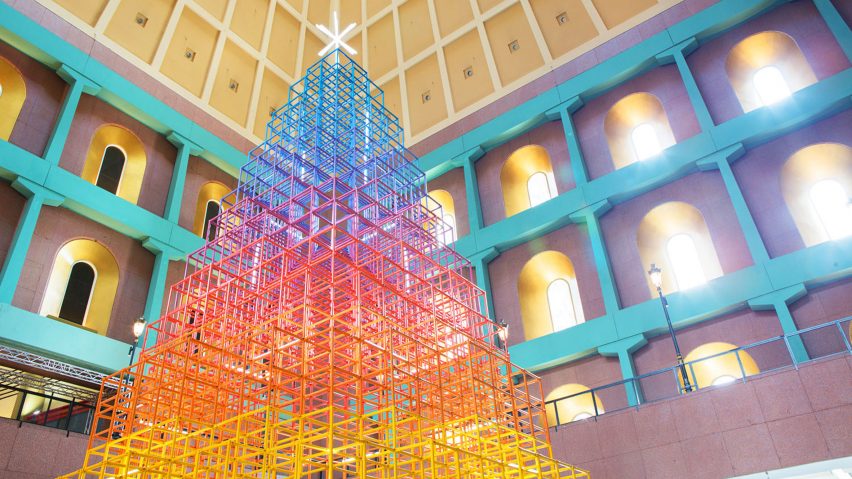We've rounded up some of our favourite Christmas trees of the year, including not one but two inspired by the Bauhaus and a Lego dragon in Christmas tree form.
The Lattice tree by OuterEdit, Singapore
Metal cubes in bright, gradient colours are stacked on top of each other to form the ten tiers of this lattice tree, designed by creative agency OuterEdit.
Visitors to Singapore's Millenia Walk shopping centre can step inside of the towering structure to watch its geometry transform, or see it lit from within through a scattering of LED lights at night.
Floris Iter by McQueens Flowers, London
This tree is constructed from eight varieties of dried flowers in various stages of dramatic decay and needs no decorations.
Blooms and petals that would otherwise have gone to waste were preserved and arranged by the florists of McQueens Flowers to form a biodegradable "tree" on top of a chicken wire frame.
BaumHaus by Sergio Sebastián, Madrid
Spanish architect Sergio Sebastián has created a triangular metal structure as the 24-metre-tall centrepiece of Madrid's Cardenal Cisneros square.
Its name merges the word Baum, which is German for tree, with Bauhaus – the 20th century design school that inspired the design's simple, geometric surfaces and is celebrating its centenary this year.
The Twelve Rebuilds of Christmas by Lego, London
Lego was tasked with creating the decorations for London's Savoy Hotel this year, filling it with a series of oversized brick-builds that reimagine classic Christmas tropes.
Beyond the dragon-shaped tree, adorned with candy canes and baubles, Santa's sleigh has been re-cast as a Harley-Davidson motorcycle.
Mandarin Oriental Jumeira tree by Kenzo Takada, Dubai
This installation by Kenzo Takada, founder of fashion brand Kenzo, takes the golden colour traditionally associated with Christmas ornaments and scales it up to cover the entire tree
Trapeze-shaped volumes are stacked to evoke the tree's classic pyramid shape, while their reflective surfaces mirror the beachfront surroundings of Dubai's Mandarin Oriental Jumeira hotel.
Tree of Liberty by Liberty London, London
The central atrium of London department store Liberty has been taken over by a floating tree installation which, although artificial, is near life-sized and appears to have been yanked out by the roots.
In an Alice in Wonderland spin, the trunk is coloured an impossible shade of blue and topped off with reindeer moss and clusters of pink, cloud-like leaves.
Spring Place tree by Sila Sveta, New York
This caged pyramid by conceptual design company Sila Sveta is meant to reflect its industrial surroundings in New York City member's club Spring Place.
On the outside, it is surrounded by a wire mesh while the internal structure is made of plexiglass that is cut with narrow groves to accommodate the colour-changing LED lights that wind around the pyramid.
Sanderson tree by Yinka Ilori, London
Continuing the theme of stacked geometries, London designer Yinka Ilori has created a simplified tree for the Sanderson hotel that evokes a pile of presents.
In keeping with his signature colourful style, each element in the timber and plywood structure is painted a different shade, with slats allowing the internal light source to radiate out.
Sketch tree by Ricky Paul Flowers, London
This installation for London restaurant Sketch looks like an oversized bonsai tree, but actually consists of a steel core wrapped in golden bark, with the branches individually dressed in scented pine, autumnal leaves, blossoms and hand-dipped wax roses.
Gold fans and crane statues are nestled into the tree, to evoke the aristocratic fashion for chinoiserie which swept the 18th-century royal court of Russia under Catherine the Great.
Bauhaus Nutcrackers by Willo Perron, LA
Creative director Willo Perron – known for creating stage designs for Drake and Rihanna's Savage x Fenty fashion show, as well as designing Kanye West's Yeezy Studio – has created a trio of totem-like sculptures for the newly opened West Hollywood branch of the Edition Hotel.
Standing at roughly two, five and eight metres tall, each of these three slowly spinning ornaments reference the paired back, primary shapes typical of the Bauhaus in lieu of following the classic Christmas tree format.

